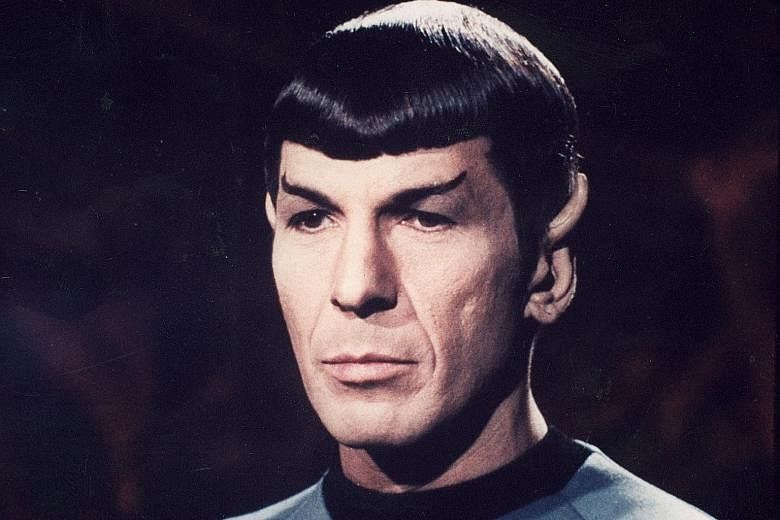BURBANK (CALIFORNIA) • Is there a more beloved character in all of science fiction than Spock, the half-human, half-Vulcan first officer from Star Trek?
He is superstrong and a whiz at science. He is cool to the point of wintry, a master at tamping down his base needs (granted, Vulcans get the urge to mate only once every seven years) and human emotions. He is skilled at martial arts, but rarely fights. He can look into your mind.
Leonard Nimoy originated the role in 1966, and when his son, Adam, began asking people what they most loved about the character while filming his new documentary, For The Love Of Spock, all that stuff - his big brain, his ability to peek into yours - was secondary.
His most attractive trait? "Ninety per cent of them were talking about the fact he's an outsider," Adam said.
Outsider indeed. Spock is that rarest of 23rd-century beings, the only son of a Vulcan dad and a human mum. For years, he was about the closest viewers could get to a multiracial role model on American television.
"I had Spock," actress Jennifer Beals, who is of Irish- and African-American descent, said in 2011. "And that was kind of it."
In For The Love Of Spock, a Nasa engineer, Mr Bobak Ferdowsi, describes being encouraged by the series and the role. "As someone who was from two cultures, Iranian father and an American mother, I saw in Spock the same conflict," he said. "Which one am I? Am I both? Is there a happy medium between the two?"
The character has inspired multiracial artists, writers and scholars almost since his inception.
Los Angeles artist Kip Fulbeck, who has created short films, museum shows and photo exhibitions about the multiracial experience, is a life-long Spock fan.
"I grew up watching Star Trek," said Fulbeck, whose father is white and mother is Chinese. "Every time McCoy would say, you're half- human, and Spock would say, I'm also half-Vulcan, I was like, 'Yeah, I get that.'"
In his film Lilo & Me (2003), Fulbeck posits Spock as possibly the "one semi-multiracial character" on TV - then cuts to a scene in which Captain Kirk, trying to shock his first officer out of a drug-induced haze, calls him a "mutinous, disloyal, computerised half-breed".
In Banana Split (1991), Fulbeck suggests Spock might have been Asian, something that hopeful Asian viewers have thought all along, given his black hair, almond eyes and yellowish skin tone. But the character has "every stereotype" too, Fulbeck admitted: good at science, emotionally detached. Spock even had a cheongsam-wearing fiancee.
In the Biracial And Multiracial Identity class she teaches at California State University, Northridge, professor of Asian-American studies Teresa Williams-Leon includes the stories of Spock; Mr Barack Obama (a self-avowed Spock fan); and Tabitha, the half-mortal daughter on Bewitched.
For Prof Williams-Leon, there is something telling about Spock's need to choose one of his selves over the other, rather than integrating the two.
"He had to subdue his emotional side to become more cerebral and logical," she said. "So that's problematic. But it's an interesting way of looking at how biracial people have had to suppress aspects of themselves or one part of themselves."
On a recent afternoon here, Adam Nimoy talked about his documentary, which is in theatres and on demand as part of the 50th- anniversary celebration of the original series.
At 60, Adam Nimoy has the strong jawline and ethnically ambiguous good looks he got from his father, who died last year.
Leonard Nimoy grew up in an immigrant Jewish family in Boston's West End and "was desperate to get out", Adam said.
"He didn't want to be stuck there. And he told me this not that long ago, by the same token, Spock's objective was to overcome the fact that he was half-alien and integrate himself with his human crewmates."
That was not always easy, particularly when colleagues were always calling attention to your mixed heritage.
In This Side Of Paradise, Captain Kirk dubs the Vulcans a "subhuman race" and ridicules Spock's "gall" in going after a lovelorn white woman (played by Jill Ireland). McCoy regularly called attention to Spock's "pointy ears" and green blood.
Adam Nimoy's documentary has a scene from the episode Day Of The Dove, in which Scotty, the Enterprise's irascible engineer, calls Spock a "freak" and screams at him: "Keep your Vulcan hands off me."
Scotty is under the evil control of alien forces, but Spock does not know this, so the dig had to sting, Spock's emotionless Vulcan side notwithstanding.
But the pain had purpose. "That was the civil rights era, when so- called law enforcement officers were using fire hoses and attack dogs," actor George Takei, who played Sulu on the show, said in a telephone interview. "Gene Roddenberry was trying to use science fiction as a metaphor for the issues of the day."
In 1968, a biracial girl wrote to "Mr. Spock", care of a teen magazine, explaining her trouble making friends because her mother is black and her father is white. She wrote: "I know that you are half-Vulcan and half-human and you have suffered because of this."
Leonard Nimoy wrote her a long letter back, telling her to believe in herself and not to let the bigots get her down.
"Hands down, the most popular reason people connect to Spock is that he makes them feel like it's okay to be an Other," Adam Nimoy said.
"It's okay to be outside the mainstream. And Spock is cool. Spock is awesome. So that makes you feel a little better about yourself too."
NYTIMES

